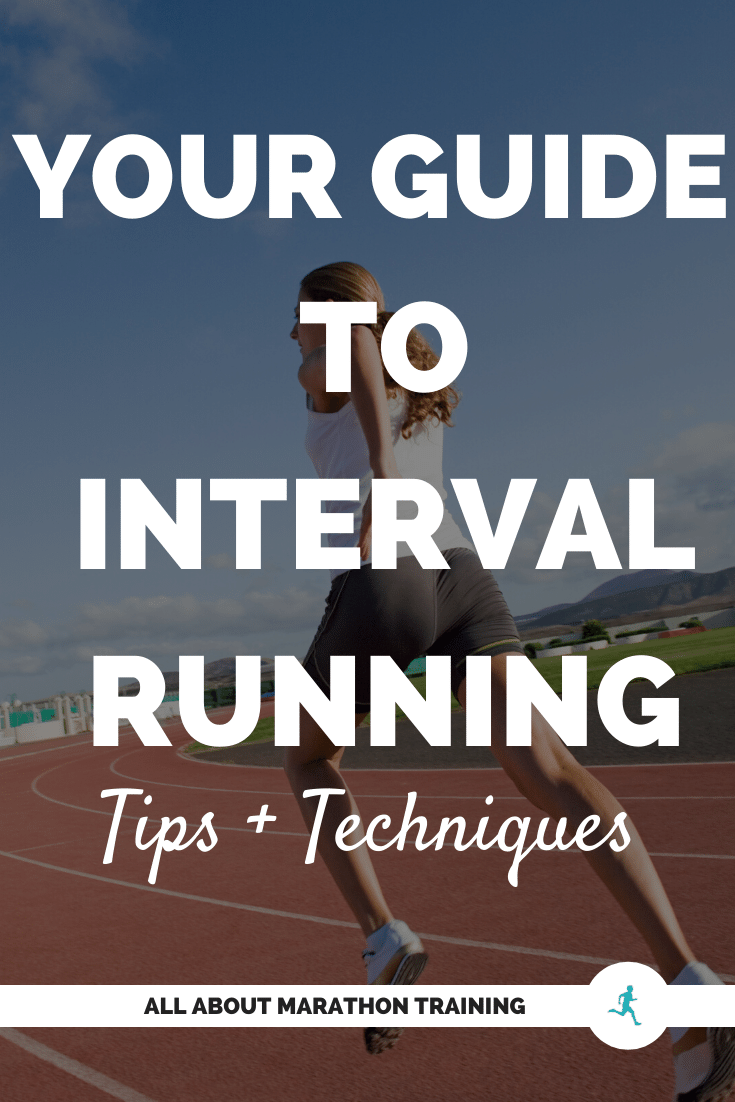Interval Training for Runners: Why, How & Techniques to Use!
If you are a marathoner or runner looking to increase your speed, interval training is the way to do it.
It is highly beneficial and results are easy to see, however you must be careful with not to over-do it with this type of speed training.
Here are some guidelines and tips.
The Reason You Should Be Running Intervals
The idea behind the interval is to run a shorter distance at a faster pace, jog to recover and repeat.
Each week of interval training you increase your speed and your repetitions to simulate a demanding race pace.
With an interval workout though you are taking recovery jogs so the demand is not quite that of a race.
This keeps your muscles from becoming as fatigued as they do during a race where you would not want to run recovery jogs obviously because it would increase your finishing time.
That is the whole goal of interval training though:
To train your legs to carry you farther and faster even when tired.
When are You Ready to Run Intervals?
Although speed workouts are very effective if you aren’t ready for fast training then you are almost guaranteed an injury.
So how do you know when you are ready?
as a beginner runner, or a recreational marathoner with no race time goal:
You really have no need for interval training at this point in time.
It just adds extra stress on your body and in fact can cause greater damage than a long run. Wait at least 3-6 months to even a year before incorporating intervals into your workouts.

For more intermediate to advanced runners:
Those who have been running for at lease 3 months to a year or longer and who have a weekly mileage of about 20-25 miles (and especially if you are training for a marathon time goal) should ease into interval training slowly and progressively.
The best way to precede a bout of interval training is to do some hill repeats for 4-6 weeks before beginning your intervals.
This will help your legs to gain strength and help you avoid injury all while increasing the capacity for you to train and become faster!
After you have completed a few weeks of hill repeat workouts then begin your interval training!
Start with 1 mile and then add on another 1/2 a mile to another full mile each week. This will reduce the risk of injury on your body by working slowly.

How long should each interval be?
Intervals are to be run at set distances or times unlike fartleks where you run fast at varying times and distances.
the most common interval distances to run are:
- 200 meters,
- 400 meters, if you are running shorter distance races such as the 10K or
- 800 (half a mile), 1,200 to even 1,600 meters (1 full mile) if you are running longer distances such as the marathon or half marathon.
Remember, once around a standard track equals 400 meters.

How to Run Intervals
1. Before you begin running intervals at any time the most important thing to remember is to warm-up.
If you jump into intervals without warming up your muscles you are running a huge risk of becoming injured as it puts a lot of stress on your cold body.
Not only this but the quality of your interval training will decrease and you won’t be able to perform as well or as long.
Do yourself a favor and never skip your warm-up (jog about 10-12 minutes and consider including some dynamic stretching).

2. Once you are warmed up, begin your interval workout
Begin your first interval. You should be running at a faster pace than your goal race pace.
For example:
If your goal pace is 8:30 per mile then try running your repeats at about 8:15-8:00 per mile or about 2:00-2:02 minutes once around the track depending on the distance of the interval you are running.

3. After you complete an interval, recover
The recovery jog in between each interval should be about half the distance of the interval that you just ran.
A runner just starting this type of training are doing this workout for the first time though can take longer recovery breaks - about the total time it took to cover the interval distance.
You can set up your an interval timer to tell you when to run and when to rest so that you don't have to worry about timing yourself and constantly checking your watch.

4. once you have done your recovery period, do the next interval
Continue running your intervals and recovering after each until you have completed all the intervals you need to run.

5. Always cool down after an interval workout
It's best to do some slow jogging or walking and then focus on stretching out your muscles following your workout.
This will help you to recover faster for the next intense workout that you need to do!

Types of Interval Training
Interval training can be tedious at times so mixing up your workouts by doing different types of intervals will help alleviate some of the monotony.
Here are the 3 most common interval Style workouts:
interval repeats:
Interval repeats keep a set constant distance instead of increasing the distance of each repeat.
For example you will run eight 200 meter repeats and recover for 100 meters. (This can also be written as 8x200M, 100R.)
The goal with this type of interval is to keep your interval running times consistent as well.
If you find that you can’t keep consistent times then you may need to adjust your time goals for each interval or go a shorter interval distance.

pyramid intervals:
Pyramids are intervals that are run at increasing and then decreasing distances or vice versa.
For example you begin running 200 meters and increase your interval distance until you reach the farthest distance you want to go (800, 1,200, or 1,600 meters) recovering after each interval.
Once you reach your farthest distance you will begin to run decreasing intervals back down to 200 meters. (1200, 800, 400, 200 meters)

ladders:
Ladders are intervals that are run at either increasing or decreasing distances but not both like pyramid workouts.
For example, run 200, then 400, 800, 1600 then end your workout instead of following with running decreasing interval distances.

How Long Can You Include Interval Training Workouts in Your Running Routine?
Any kind of speed training is highly fatiguing and so should NOT be carried on for months on end.
Your body needs to rest in order to be able to reach a peak, and make muscle adaptations so that you can become faster!
Therefore, include interval training only about 8-12 weeks at a time.
At the end of speed training your body should be nearly at peak level and be ready to pound out a fast and hard race.
Speed training for much longer than 8-12 weeks can actually cause you to regress in your performance since your body keeps being put under too much stress.
Tips for Running Intervals
- If you are running a marathon your ideal goal for total distance of intervals will be about 6-12 miles of running 1 mile intervals at slightly faster race pace and recovering after each.
- Interval training will be very tiring but leave your workout knowing that if you wanted to you could do more. Never push yourself to your absolute limit.
- Keep your recovery jogs very slow . Walking is best if you are doing intervals while marathon training which requires you to do more.
- Make sure you get plenty of rest. Never do two days of speed work back to back and it is good to rest for at least two days after an interval training workout. Too much makes your body too susceptible to injury and sickness.
- The most common place to run an interval is on a track as it you can be sure of the distance you are running. If running on the track is too boring for you then pick a spot, road, etc. where you know how long the distance is. Knowing the distance makes your workout meaningful and is the main difference between fartlek and interval workouts.
- Also, check out this page on breathing tips and techniques to learn how to breathe properly while running intervals to increase your efficiency.
Related Pages:
👋Sign up to receive the free printable strength exercises for runners: 👇
 |
As featured on:












New! Comments
Have your say about what you just read! Leave me a comment in the box below.